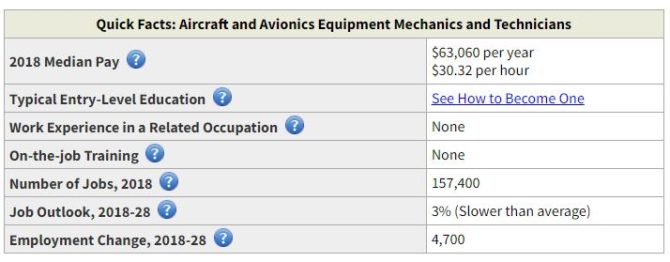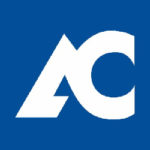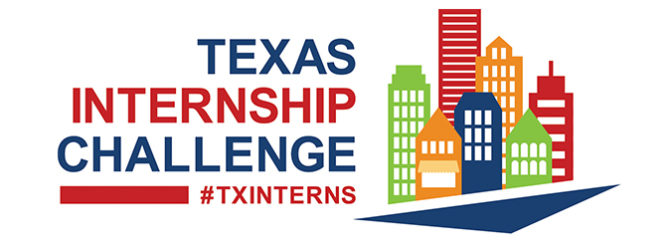- All Occupations
- Featured Occupations
- Installation, Maintenance, and Repair Occupations
- Military Occupations
- Production Occupations
Aircraft Mechanic
Angela | January 14, 2020
749 Views
81 Likes
4.73
On 15 Ratings
Related
- All Occupations
- Featured Occupations
- Installation, Maintenance, and Repair Occupations
- Military Occupations
- Production Occupations
Aircraft Mechanic
 Aircraft and avionics equipment mechanics and technicians repair and perform scheduled maintenance on aircraft. Most aircraft and avionics equipment mechanics and technicians learn their trade at an Federal Aviation Administration (FAA)-approved aviation maintenance technician school or on the job. Some learn through training received in the military.
Aircraft and avionics equipment mechanics and technicians repair and perform scheduled maintenance on aircraft. Most aircraft and avionics equipment mechanics and technicians learn their trade at an Federal Aviation Administration (FAA)-approved aviation maintenance technician school or on the job. Some learn through training received in the military.
Aircraft and avionics equipment mechanics and technicians repair and perform scheduled maintenance on aircraft.
Duties
Aircraft mechanics typically do the following:
- Diagnose mechanical or electrical problems
- Repair wings, brakes, electrical systems, and other aircraft components
- Replace defective parts, using hand tools or power tools
- Examine replacement aircraft parts for defects
- Read maintenance manuals to identify repair procedures
- Test aircraft parts with gauges and other diagnostic equipment
- Inspect completed work to ensure that it meets performance standards
- Keep records of maintenance and repair work
Avionics technicians typically do the following:
- Test electronic instruments, using circuit testers, oscilloscopes, and voltmeters
- Interpret flight test data to diagnose malfunctions and performance problems
- Assemble components, such as electrical controls and junction boxes, and install software
- Install instrument panels, using hand tools, power tools, and soldering irons
- Repair or replace malfunctioning components
- Keep records of maintenance and repair work
Airplanes require reliable parts and maintenance in order to fly safely. To keep an airplane in operating condition, aircraft and avionics equipment mechanics and technicians perform scheduled maintenance, make repairs, and complete inspections. They must follow detailed regulations set by the Federal Aviation Administration (FAA) that dictate maintenance schedules for different operations.
Many mechanics are generalists and work on many different types of aircraft, such as jets, piston-driven airplanes, and helicopters. Others specialize in one section, such as the engine, hydraulic system, or electrical system, of a particular type of aircraft. In independent repair shops, mechanics usually inspect and repair many types of aircraft.
The following are examples of types of aircraft and avionics equipment mechanics and technicians:
Airframe and Powerplant (A&P) mechanics are certified generalist mechanics who can independently perform many maintenance and alteration tasks on aircraft. A&P mechanics repair and maintain most parts of an aircraft, including the engines, landing gear, brakes, and air-conditioning system. Some specialized activities require additional experience and certification.
Maintenance schedules for aircraft may be based on hours flown, days since the last inspection, trips flown, or a combination of these factors. Maintenance also may need to be done at other times to address specific issues recognized by mechanics or manufacturers.
Mechanics use precision instruments to measure wear and identify defects. They may use x rays or magnetic or ultrasonic inspection equipment to discover cracks that cannot be seen on a plane’s exterior. They check for corrosion, distortion, and cracks in the aircraft’s main body, wings, and tail. They then repair the metal, fabric, wood, or composite materials that make up the airframe and skin.
After completing all repairs, mechanics test the equipment to ensure that it works properly and record all maintenance completed on an aircraft.
Avionics technicians are specialists who repair and maintain a plane’s electronic instruments, such as radio communication devices and equipment, radar systems, and navigation aids. As the use of digital technology increases, more time is spent maintaining computer systems. The ability to repair and maintain many avionics and flight instrument systems is granted through the Airframe rating, but other licenses or certifications may be needed as well.
Designated airworthiness representatives (DARs) examine, inspect, and test aircraft for airworthiness. They issue airworthiness certificates, which aircraft must have to fly. There are two types of DARs: manufacturing DARs and maintenance DARs.
Inspection authorized (IA) mechanics are mechanics who have both Airframe and Powerplant certification and may perform inspections on aircraft and return them to service. IA mechanics are able to do a wider variety of maintenance activities and alterations than any other type of maintenance personnel. They can do comprehensive annual inspections or return aircraft to service after a major repair.
Repairmen certificate holders may or may not have the A&P certificate or other certificates. Repairmen certificates are issued by certified repair stations to aviation maintenance personnel, and the certificates allow them to do specific duties. Repairmen certificates are valid only while the mechanic works at the issuing repair center and are not transferable to other employers.
Aircraft mechanics and service technicians held about 136,900 jobs in 2018. The largest employers of aircraft mechanics and service technicians were as follows:
| Support activities for air transportation | 28% |
| Scheduled air transportation | 24 |
| Aerospace product and parts manufacturing | 13 |
| Federal government, excluding postal service | 12 |
| Nonscheduled air transportation | 6 |
Avionics technicians held about 20,600 jobs in 2018. The largest employers of avionics technicians were as follows:
| Aerospace product and parts manufacturing | 32% |
| Support activities for air transportation | 25 |
| Scheduled air transportation | 9 |
| Federal government | 8 |
| Professional, scientific, and technical services | 6 |
Aircraft and avionics equipment mechanics and technicians work in hangars, in repair stations, or on airfields. They must meet strict deadlines while following safety standards.
Most of these mechanics and technicians work near major airports. They may work outside on the airfield, or in climate-controlled shops and hangars. Civilian aircraft and avionics equipment mechanics and technicians employed by the U.S. Armed Forces work on military installations.
Injuries and Illnesses
Aircraft and avionics equipment mechanics and technicians often lift heavy objects, handle dangerous chemicals, or operate large power tools. They may work on scaffolds or ladders, and noise and vibrations are common, especially when engines are being tested. Workers must take precautions against injuries, such as wearing ear protection and brightly colored vests to ensure that they are seen when working around large aircraft.
Work Schedules
Aircraft and avionics equipment mechanics and technicians usually work full time on rotating 8-hour shifts. Overtime and weekend work are common.
Some aircraft and avionics equipment mechanics and technicians learn their trade at an Federal Aviation Administration (FAA)-approved aviation maintenance technician school. Others are trained on the job or learn through training in the military. Aircraft mechanics and avionics technicians typically are certified by the FAA. (See Title 14 of the Code of Federal Regulations (14 CFR), part 65, subparts D and E, for the most current requirements for becoming a certified mechanic.)
Education
Aircraft mechanics and service technicians typically enter the occupation after attending a Part 147 FAA-approved aviation maintenance technician school. These schools award a certificate of completion that the FAA recognizes as an alternative to the experience requirements stated in regulations. The schools also grant holders the right to take the relevant FAA exams.
Avionics technicians typically earn an associate’s degree before entering the occupation. Aircraft controls, systems, and flight instruments have become increasingly digital and computerized. Workers who have the proper background in aviation flight instruments or computer repair are needed to maintain these complex systems
Training
Some aircraft mechanics and service technicians enter the occupation with a high school diploma or equivalent and receive on-the-job training to learn their skills and to be able to pass the FAA exams. Aviation maintenance personnel who are not certified by the FAA work under supervision until they have enough experience and knowledge and become certified.
Licenses, Certifications, and Registrations
The FAA requires that aircraft maintenance be done either by a certified mechanic with the appropriate ratings or authorizations or under the supervision of such a mechanic.
The FAA offers separate certifications for bodywork (Airframe mechanics, or “A”) and engine work (Powerplant mechanics, or “P”), but employers may prefer to hire mechanics who have both Airframe and Powerplant (A&P) ratings. The A&P ratings generally certify that aviation mechanics meet basic knowledge and ability standards.
Mechanics must be at least 18 years of age, be fluent in English, and have 30 months of experience to qualify for either the A or the P rating or both (the A&P rating). Completion of a program at a Part 147 FAA-approved aviation maintenance technician school can substitute for the experience requirement and shorten the time requirements for becoming eligible to take the FAA exams.
Applicants must pass written, oral, and practical exams that demonstrate the required skills within a timeframe of 2 years.
To keep their certification, mechanics must have completed relevant repair or maintenance work within the previous 24 months. To fulfill this requirement, mechanics may take classes from their employer, a school, or an aircraft manufacturer.
The Inspection Authorization (IA) is available to mechanics who have had their A&P ratings for at least 3 years and meet other requirements. These mechanics are able to review and approve many major repairs and alterations.
Avionics technicians typically are certified through a repair station for the specific work they perform on aircraft, or they hold the Airframe rating to work on an aircraft’s electronic and flight instrument systems. An Aircraft Electronics Technician (AET) certification is available through the National Center for Aerospace & Transportation Technologies (NCATT). It certifies that aviation mechanics have a basic level of knowledge in the subject area, but it is not required by the FAA for any specific tasks. Avionics technicians who work on communications equipment may need to have the proper radiotelephone operator certification issued by the Federal Communications Commission (FCC).
Work Experience in a Related Occupation
Some avionics technicians begin their careers as aircraft mechanics and service technicians. As aircraft mechanics and service technicians gain experience, they may attend classes or otherwise choose to pursue additional certifications that grant privileges to work on specialized flight instruments. Eventually, they may become avionics technicians who work exclusively on flight instruments.
Advancement
As aircraft mechanics gain experience, they may advance to lead mechanic, lead inspector, or shop supervisor. Opportunities to advance may be best for those who have an inspection authorization (IA). Mechanics with broad experience in maintenance and repair may become inspectors or examiners for the FAA.
Important Qualities
Detail oriented. Mechanics and technicians need to adjust airplane parts to exact specifications. For example, they often use precision tools to tighten wheel bolts to a specified tension.
Dexterity. Mechanics and technicians need to coordinate the movement of their fingers and hands in order to grasp, manipulate, or assemble parts.
Observational skills. Mechanics and technicians must recognize engine noises, read gauges, and collect other information to determine whether an aircraft’s systems are working properly.
Strength. Mechanics and technicians may carry or move heavy equipment or aircraft parts, climb on airplanes, balance, and reach without falling.

The median annual wage for aircraft mechanics and service technicians was $62,920 in May 2018. The median wage is the wage at which half the workers in an occupation earned more than that amount and half earned less. The lowest 10 percent earned less than $36,760, and the highest 10 percent earned more than $97,820.
The median annual wage for avionics technicians was $64,140 in May 2018. The lowest 10 percent earned less than $39,940, and the highest 10 percent earned more than $94,710.
In May 2018, the median annual wages for aircraft mechanics and service technicians in the top industries in which they worked were as follows:
| Scheduled air transportation | $83,870 |
| Aerospace product and parts manufacturing | 64,510 |
| Federal government, excluding postal service | 59,530 |
| Nonscheduled air transportation | 59,020 |
| Support activities for air transportation | 54,350 |
In May 2018, the median annual wages for avionics technicians in the top industries in which they worked were as follows:
| Scheduled air transportation | $81,160 |
| Aerospace product and parts manufacturing | 72,420 |
| Professional, scientific, and technical services | 71,650 |
| Federal government | 58,420 |
| Support activities for air transportation | 57,210 |
Mechanics and technicians usually work full time on rotating 8-hour shifts. Overtime and weekend work are common.
Overall employment of aircraft and avionics equipment mechanics and technicians is projected to grow 3 percent from 2016 to 2026, slower than the average for all occupations. Employment growth will vary by occupation (see table below).
Air traffic is expected to increase gradually over the coming decade, and will require additional aircraft maintenance, including that performed on new aircraft. Some airlines may outsource maintenance work to specialized maintenance and repair shops both domestically and abroad. This practice is expected to reduce employment growth opportunities in the air transportation industry over the next 10 years.
Job Prospects
Job opportunities are expected to be good because there will be a need to replace those workers leaving the occupation.
Bureau of Labor Statistics, U.S. Department of Labor, Occupational Outlook Handbook, Aircraft and Avionics Equipment Mechanics and Technicians,
on the Internet at https://www.bls.gov/ooh/installation-maintenance-and-repair/aircraft-and-avionics-equipment-mechanics-and-technicians.htm (visited December 26, 2019).
Salary information comes from the Bureau of Labor Statistics, Occupational Employment Statistics Program, a semi-annual survey that provides wage and employment statistics for the nation, each state, and sub-state regions.
Tagged as AC, Aircraft Mechanic, Amarillo College, Aviation Maintenance Technician, Bell Textron, Career, Education, Helicopter, Hometown Success, Jobs Ya'll, Military, Occupation, Region 16, Texas, Texas Panhandle, Texas Workforce Commission, Veteran, Workforce Solutions Panhandle.
Written by Angela








